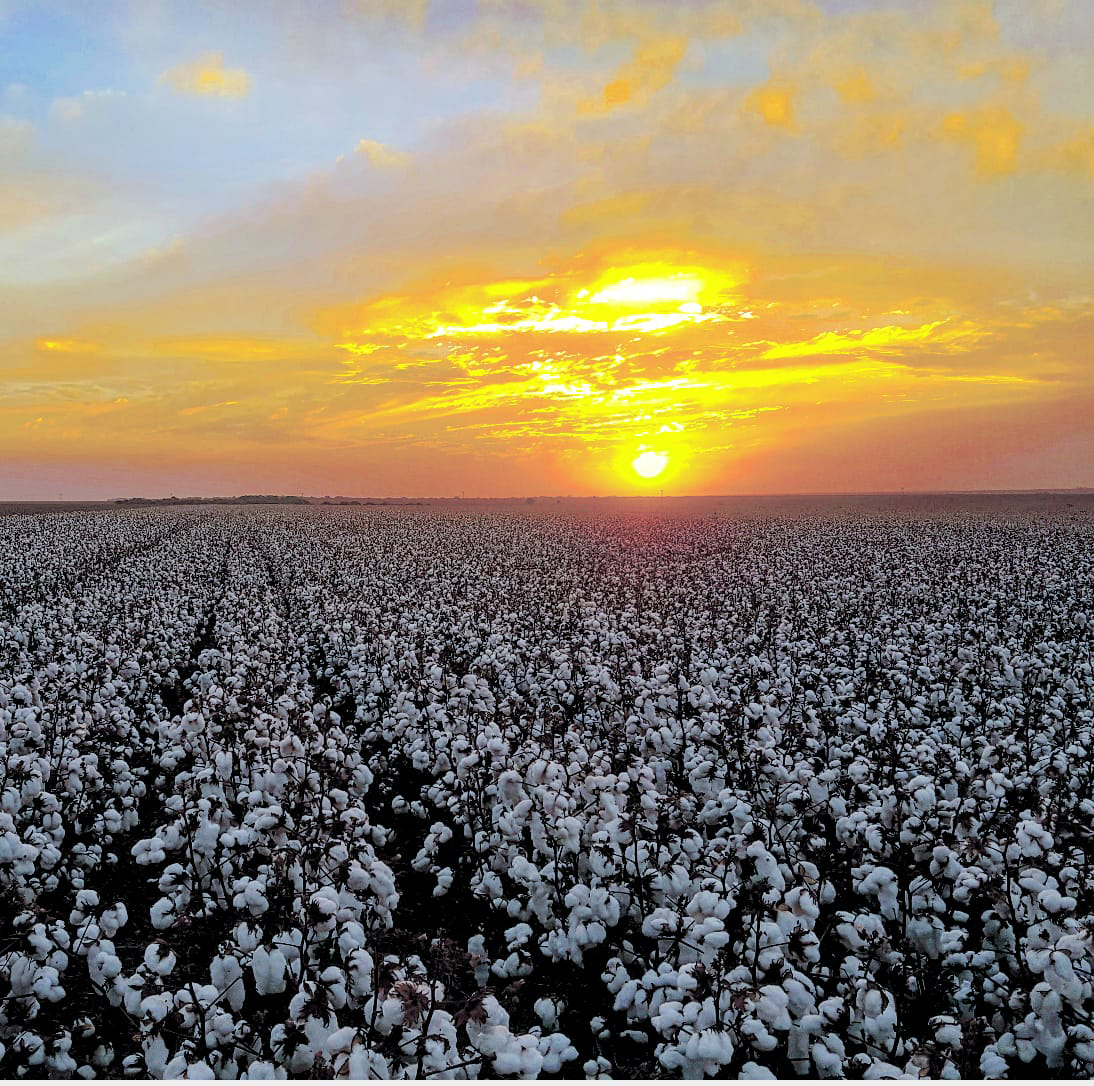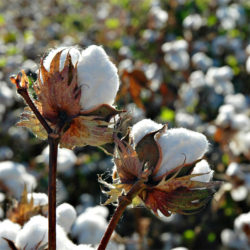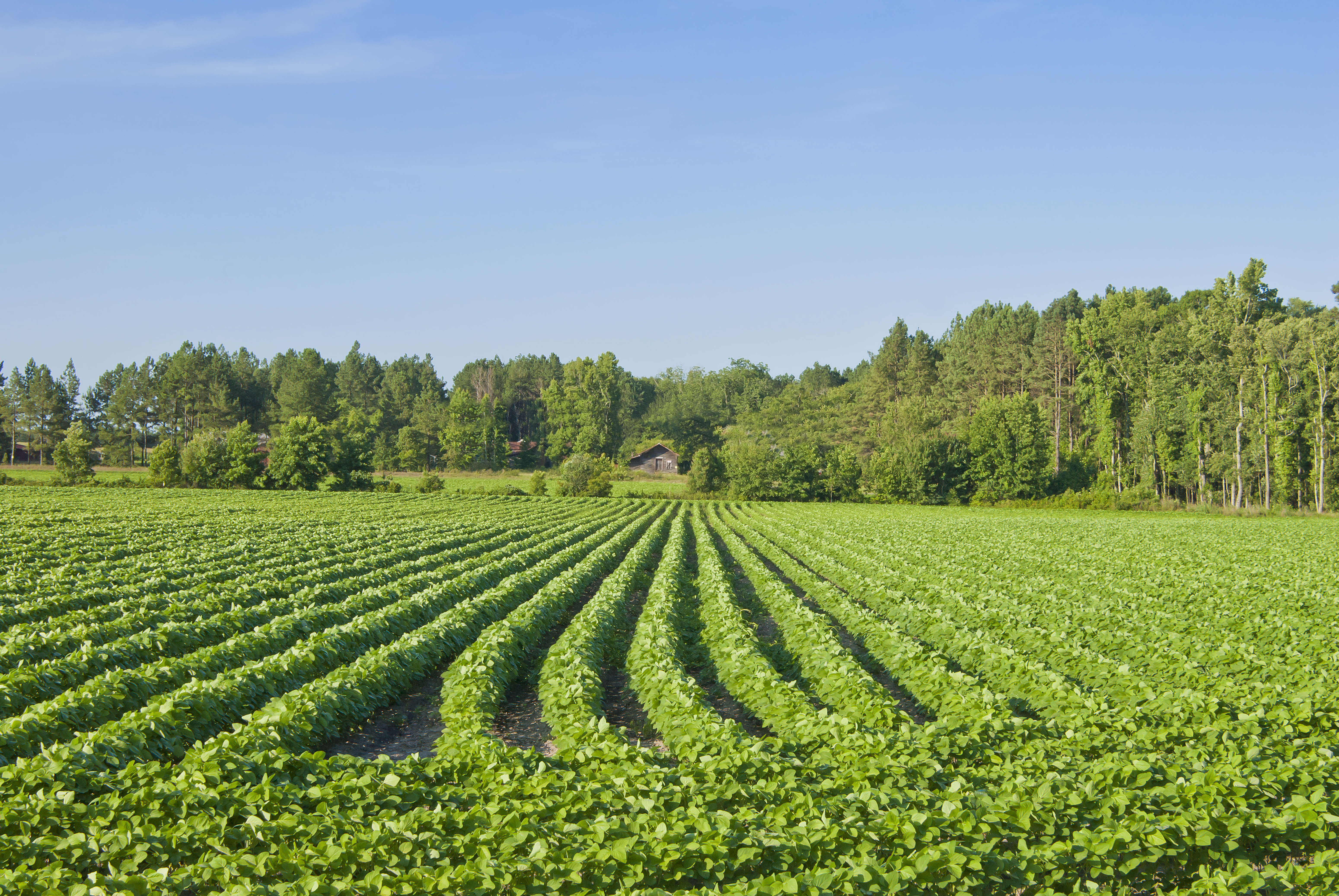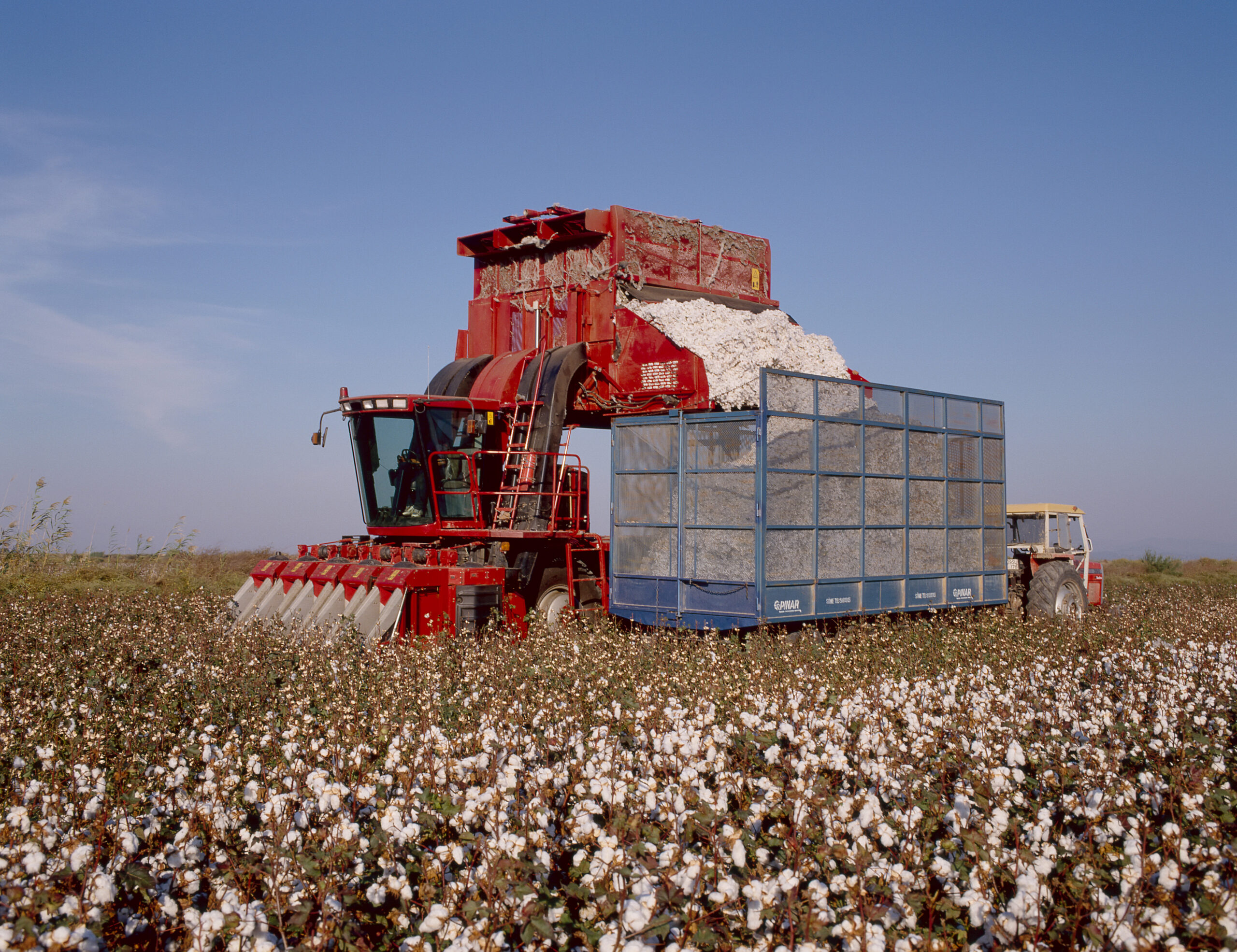
Dr Terry Mabett speaks with technical sales manager for Africa, Dr Ben Odunlami and Managing Director Peter Prentis about the nutrient requirements of cotton and how these are fulfilled by foliar feeding.
DESPITE THE RISE of synthetics, cotton is still the natural fibre that is supplied to half the world’s textile industry. Hence, it is no surprise that cotton has an important position in African agriculture and the wider African economy.
Cotton is an important export, providing Africa’s fast-growing textile industry with resources. It is a crucial cash crop which supports subsistence farming of food crops. But it is not all smooth sailing because the crop is bombarded with insect pests, right from when the first seedling leaves push through the soil till the bolls (the rounded seed capsule of the crop) split and cotton lint is gathered.
The importance of cotton crop’s nutrition extends beyond proper plant growth and development. The length and strength of lint fibre can get adversely affected by nutritional imbalance, which, in turn can make or break its marketability. Then, there is a complex situation around crop nutrition and plant health, which is not always easy to separate. Providing the right nutrients at the right time is crucial for plant health and crop resilience to insect attack. However, nutrient imbalance, can, by the same token, increase plant and crop vulnerability and susceptibility to attack by specific pests.
Complementary feeding through cotton foliage
Cotton is invariably cultivated in monoculture, with an accompanying drain on soil nutrients from harvested cotton seed, lint and crop debris cleared before planting the next crop.
Macro-nutrients – nitrogen, phosphorous and potassium – are traditionally replenished before or while planting with solid base fertiliser, although they are insufficient to meet requirements throughout the crop cycle. This may be due to a drain on a particular macronutrient later in crop development, which is the case for potassium at the post-peak flowering stage in cotton. More generally, it is also because a large proportion of a nutrient is locked up in the soil and therefore unavailable for uptake, a frequently prevailing situation for phosphorous. Phosphorous is required ‘on-tap’ and in substantial amounts for early and rapid root formation and secure seedling establishment.
Nitrogen is not needed in large amounts until the squaring stage – flower bud formation which is five to seven weeks after planting – but high nutrient leaching during this period can deplete base nitrogen, especially where planting coincides with the rainy season.
Requirements for meso-nutrients like magnesium and micronutrients come in at specific times in the crop cycle and foliar feeding is the only practical way of meeting these nutrient needs in cotton.
Foliar feeding the Omex way
Farmers and even agronomists do not generally associate cotton with foliar feeding. However, this is certainly not the case at Omex Agrifluids in the United Kingdom, which designs and develops soluble nutrient delivery systems (formulations) and products for cotton.

Focusing on distinct developmental stages is the most appropriate way to assess the nutrient needs of cotton.
Technical sales manager for Africa, OMEX Agrifluids and its managing director Peter Prentis spoke about the nutrient requirements of cotton and how these are fulfilled by foliar feeding (complementary to base fertilisation). Their remit for product development and marketing – Ben in sub-Saharan Africa and Peter across Asia and the Middle East – allows them to service a considerable chunk of the world’s cotton cultivation. Drawing from their experience, they elaborated the salient points about cotton, with regard to crop nutrition.
Speaking at the company’s headquarters, research laboratories and manufacturing facilities in Kings Lynn, England, they said that a pivotal point is the long tap root system of cotton. It provides secure anchorage for what will become not only a large plant carrying a considerable load in bolls but also one with problems for access to nutrients. Dr Odunlami said, “The consequences of this are low root densities in the surface soil layers where a majority of nutrients are present and deficits in uptake, especially for specific micronutrients or trace elements.”
“It is not so much a problem of nutrient unavailability but more a question of root system access to the pool of soil nutrients. This is the underlying reason why cotton requires correctly balanced applications of foliar nutrients at key stages of growth throughout the crop cycle to overcome potential deficiencies and attain full potential in both yield and lint fibre quality,” added Prentis. “The nutrients may well exist in the soil but root access is a problem, which is why foliar feeding is required,” said Dr Odunlami.
Well-defined crop cycle
The well-defined cotton crop cycle makes nutritional considerations and requirements that are much easier to define and deliver. Agronomists can identify the exact stage at which a specific nutrient is required and supply it in soluble form and in good time by foliar feeding. Focusing on distinct developmental stages is the most appropriate way to assess the nutrient needs of cotton. Dr Odunlami has drawn up ‘Omex Programme for Cotton in Africa’, specifying products, recommended rates and application timing, synchronised with specific stages of crop development.
Early post-emergence plant growth
The early growth stage in cotton covers the period of the seedlings pushing through the soil till the plants are at the ‘squaring’ stage (flower bud stage), at 35 to 49 days after planting. This is an uncertain time for the seedlings because like all other young plants, they require an uninterrupted supply of phosphorous – a highly immobile nutrient – for early root development and swift and secure establishment. Prentis informed that despite a high phosphorous content, many soils show low availability of the chemical, especially under alkaline conditions. “Phosphorous deficiency causes reduced seedling vigour, poor plant establishment and root development which eventually translates into delayed fruiting and plant maturity,” added Dr Odunlami.
However, cotton has to struggle with other problems – insect pests to be exact, including sucking pests which descend on the tiny plants during their first few days in the sunlight. Aphids, jassids (leafhoppers), thrips and whiteflies are among the sucking insects which exploit these young and highly tender seedlings, especially in irrigated cotton. Tiny seedlings carrying just two or three leaves don’t need many pest insects per leaf before the damage becomes terminal. Cotton cultivated under rain-fed conditions is less susceptible to insect pests. Rainfall washes a high proportion of insects off the plants which end up growing more rapidly.
Omex Bio20 gets cotton off to a flying start
When asked if foliar-applied soluble product providing a full complement of immediately available essential nutrients (including phosphorous), is an answer to the early growth stage, Dr Odunlami said, “We have designed and developed Omex Bio20 to deliver the required stimulation and boost for young cotton plants at this time and to get the cotton crop off to a flying start.”
OMEX Bio20 is a highly concentrated liquid emulsion product containing macronutrients, including phosphorous at 20.00% w/v (weight by volume), along with a full complement of chelated
micronutrients.
However, the unique and key ingredient of OMEX Bio20 is an organic material derived from a specific marine alga (seaweed) with proven and established bio stimulant effects to
promote root development. OMEX Bio20 can be used at any stage in the crop cycle but Prentis pointed out this novel product is most highly valued and critical at this early growth stage when stressful conditions caused by abiotic (drought) and biotic (pests and diseases) factors hit the young and tender cotton plants hard. Recommendations for OMEX Bio20 within the OMEX Programme for Cotton are one to two foliar sprays given to young plants early in the crop cycle (the first at 25 days after seedling emergence) at 2-3 litres (l)/product per hectare (ha). “The enhanced root biomass thus achieved, facilitates an increased uptake of water and nutrients,” informed Dr Odunlami. Sound seedling establishment allowing prompt and early top growth is essential to mitigate any early-season invasion by insect pests.
Calcium and Boron in a single product
First flower buds start to show around 45 days after planting with flowers opening 15 to 20 days later. However, if fruiting (boll formation and ripening) has to achieve full potential, farmers need
to meet the crop’s requirements for two key nutrients during this pre-flowering period – calcium and boron.
Calcium is a well-established meso-nutrient (secondary nutrient) while boron is the least understood and appreciated micro-nutrient. Functionally, they are under the same category of ‘maintenance nutrients’ and a deficiency of these can cause a range of symptoms related to impaired flower bud development and shedding of squares (flower buds).
Cotton farmers outside Africa are generally forced to use two separate products, one containing calcium and the other boron, but African cotton farmers, with access to the ‘OMEX Programme for Cotton in Africa’, have the benefit of a single product called CalMaxB. The two vital nutrients for cotton, Calcium and Boron, are present in CalMaxB at 23.00% w/v and 1.53% w/v respectively. Other components are nitrogen (16.80% w/v), magnesium (2.40% w/v), manganese (0.10% w/v), iron (0.10% w/v), copper (0.05% w/v), zinc (0.05% w/v) and molybdenum (0.001% w/v).
Compared to other crops, cotton has a very high requirement for boron. “Boron is required for normal flower development and to maintain the boll load. It allows cotton to develop and retain more flower buds (squares) while also enhancing floral pollination and fruit (boll) set, while adequate calcium nutrition minimises shedding of squares and immature bolls. Boron deficiency causes flower distortion, flower drop and later, boll shedding,” added Dr Odunlami.
Calcium is required once the reproductive phase of crop development is underway in a crucial strengthening and resilience capacity. However, the calcium nutrient has traditionally suffered serious, soil-related, supply problems due to inherent immobility with a consequent negative impact on the availability to the cotton plant via the root system.
Prentis explained that CalmaxB is a ‘double-barrelled’ and ‘twoin- one’ answer to the requirement of calcium and boron in the cotton plant. “Recommended applications are 1.0 l/ha when the first flower buds show and thereafter at 20-day interval through the squaring, flowering and boll formation periods of crop development,” he added.

A strict programme of foliar feeding has helped this cotton crop successfully make it through the vegetative phase.
Post-flowering cotton
Flowering period starts with the first sign of squares at five to seven weeks after planting and continues for up to 10 weeks thereafter. This is the most crucial period when the harvest is essentially
secured in yield and lint quality. This is the time when lint quality and ultimate grade of cotton – measured in fibre length, strength and fineness – is established and secured, and depends largely on a readily available and accessible supply of nutrients. It is too late to wait until the bolls split and the white fluffy lint is exposed at 18 to 20 weeks, as this is the time when nutrient status underpins and secures the success or failure of the cotton harvest gathered in some 25 weeks post sowing. “All nutrients are important but some are more vital than the others during the critical post flowering and boll formation period when the template for lint quality is laid down,” said Dr Odunlami.
Prime time for Potassium
“Potassium is the prime nutrient on our agenda at this post-peak flowering stage because this is the time when demand for the socalled ‘gatekeeper’ nutrient regularly outstrips ability of the soil to supply it,” Prentis informed. Potassium has a well-established and continuous role in water relations, including stomatal movements and cell homeostasis, while late-season shortfalls of potassium can lead to severe defoliation, boll shedding and severe reductions in lint fibre quality.
“The rapid and reassuring answer to potassium deficiency in African cotton is OMEX K41, a highly concentrated water soluble emulsion product containing potassium (39.0% w/v) and nitrogen (11.10% w/v),” added Dr Odunlami. Potassium deficiency is generally characterised by light mottling of the leaves around the margins and between the veins. Leaf tips and margins curl downwards with leaves ultimately assuming a rusty-red colour, becoming brittle and falling off prematurely with catastrophic consequences for yield and lint quality.
OMEX recommends that growers start using OMEX K41 at the end of the flowering period with an initial application of 0.5 l/ha, followed by two further applications (1.0 l/ha), at 20 days and 40 days thereafter. “This covers cotton from the beginning to the end of boll development and boll ripening,” Dr Odunlami said. This ‘programme of potassium’ will accelerate and even-out boll splitting with benefits in ease of harvesting and yield,” Prentis informed.
Seastar- F for a regular boost to cotton
Last but not least is OMEX Seastar-F, a concentrated solution of seaweed extract containing nutrients (N, P and K), iodine, mannitol, laminarin and amino acids, and crucially biostimulatory and bioactive compounds such as cytokinin and gibberellin. Six applications at 1.0 l/ha of OMEX Seastar-F, starting one week after seedling emergence and repeated at 21 day intervals thereafter, heightens resilience to stress-related, abiotic and biotic factors including high temperature, drought and disease.

A complete programme of foliar feeding is required throughout the crop cycle of cotton
Article written by: Dr Terry Mabbett
